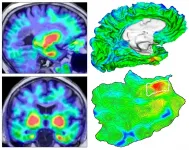INFORMATION:
Automated imaging reveals where TAU protein originates in the brain in Alzheimer's disease
2021-01-20
(Press-News.org) Researchers have developed an automated method that can track the development of harmful clumps of TAU protein related to Alzheimer's disease in the brain, according to work involving 443 individuals. The method revealed that TAU primarily emerged in an area of the brain called the rhinal cortex before spreading elsewhere, suggesting that targeting TAU here could potentially slow the progression of Alzheimer's disease. The buildup of toxic amyloid-beta and TAU proteins is responsible for many of the symptoms and damage to neurons seen in Alzheimer's disease. However, current therapies have shown reduced efficacy, at least in part because the therapies were administered long after the protein had spread throughout the brain. Developing more effective interventions therefore requires a better understanding of where TAU pathology originates and how it spreads. Justin Sanchez and colleagues designed an automated anatomic sampling method that uses PET imaging to track the presence of TAU in the brain. The team applied their technique to 443 adult participants - including 55 patients with Alzheimer's - and discovered that TAU deposits first emerged in the rhinal cortex independently from amyloid-beta before spreading to the temporal neocortex. A two-year experiment with 104 subjects showed that people with the highest initial levels of TAU or amyloid beta displayed the most spread of TAU throughout the brain by the end of the study. "These findings suggest that [the rhinal cortex] is a biomarker of downstream TAU spread ... with potential utility for therapeutic trials in which reduction of TAU spread is an outcome measure," the authors conclude.
ELSE PRESS RELEASES FROM THIS DATE:
Deep sleep takes out the trash
2021-01-20
A new Northwestern University study reaffirms the importance of getting a good night's sleep.
By examining fruit flies' brain activity and behavior, the researchers found that deep sleep has an ancient, restorative power to clear waste from the brain. This waste potentially includes toxic proteins that may lead to neurodegenerative disease.
"Waste clearance could be important, in general, for maintaining brain health or for preventing neurogenerative disease," said Dr. Ravi Allada, senior author of the study. "Waste clearance may occur during wake and sleep but is substantially enhanced during deep sleep."
The ...
Intoxicating chemicals in catnip and silver vine protect felines from mosquito bites
2021-01-20
Rubbing against catnip and silver vine transfers plant chemicals that researchers have now shown protect cats from mosquitoes. The results also demonstrate that engaging with nepetalactol, which the study identified as the most potent of many intoxicating iridoid compounds found in silver vine, activates the opioid reward system in both domesticated felines and big jungle cats. While nepetalactol had been previously identified, these studies directly illuminate its extremely potent effect on cats. And by revealing the biological significance of well-known feline behaviors, ...
Methamphetamine overdose deaths rise sharply nationwide
2021-01-20
Methamphetamine overdose deaths surged in an eight-year period in the United States, according to a study published today in JAMA Psychiatry. The analysis revealed rapid rises across all racial and ethnic groups, but American Indians and Alaska Natives had the highest death rates overall. The research was conducted at the National Institute on Drug Abuse (NIDA), part of the National Institutes of Health.
Deaths involving methamphetamines more than quadrupled among non-Hispanic American Indians and Alaska Natives from 2011-2018 (from 4.5 to 20.9 per 100,000 people) overall, with ...
Diabetes powerfully associated with premature coronary heart disease in women
2021-01-20
BOSTON -- While deaths related to heart disease have declined among older people, studies suggest that death rates among younger patients have remained stagnant or increased slightly. To understand what factors put younger individuals at higher risk of premature coronary heart disease (CHD), researchers from Brigham and Women's Hospital and the Mayo Clinic analyzed more than 50 risk factors in 28,024 women who participated in the decades-long Women's Health Study. Notably, women under 55 with type-2 diabetes had a tenfold greater risk of having CHD over the next two decades, with lipoprotein insulin resistance ...
New metamaterial offers reprogrammable properties
2021-01-20
Over the past 20 years, scientists have been developing metamaterials, or materials that don't occur naturally and whose mechanical properties result from their designed structure rather than their chemical composition. They allow researchers to create materials with specific properties and shapes. Metamaterials are still not widely used in everyday objects, but that could soon change. Tian Chen, a post-doc at two EPFL labs - the Flexible Structures Laboratory, headed by Pedro Reis, and the Geometric Computing Laboratory, headed by Mark Pauly - has taken metamaterials one step further, ...
Associations of government-mandated closures, restrictions with mobility, SARS-CoV-2 infections in Nigeria
2021-01-20
What The Study Did: This observational study examined how COVID-19-related government-mandated closures and restrictions were associated with changes in mobility and the spread of COVID-19 in Nigeria.
Author: Daniel O. Erim, M.D., Ph.D., M.Sc., of Parexel International in Durham, North Carolina, is the corresponding author.
To access the embargoed study: Visit our For The Media website at this link https://media.jamanetwork.com/
(doi:10.1001/jamanetworkopen.2020.32101)
Editor's Note: Please see the article for additional information, including other authors, author contributions and affiliations, conflict of interest and financial disclosures, and funding and support.
# ...
Stanford study reveals immune driver of brain aging
2021-01-20
Suppose Smokey the Bear were to go on a tear and start setting forest fires instead of putting them out. That roughly describes the behavior of certain cells of our immune system that become increasingly irascible as we grow older. Instead of stamping out embers, they stoke the flames of chronic inflammation.
Biologists have long theorized that reducing this inflammation could slow the aging process and delay the onset of age-associated conditions, such as heart disease, Alzheimer's disease, cancer and frailty, and perhaps even forestall the gradual loss of mental acuity that happens to nearly everyone.
Yet the question of ...
Factors associated with US public motivation to use, distribute COVID-19 self-tests
2021-01-20
What The Study Did: Researchers examined individuals' motivation to self-test and to distribute self-test kits given the urgent need to increase COVID-19 testing coverage and contact tracing.
Author: Cedric Bien-Gund, M.D., of the Perelman School of Medicine at the University of Pennsylvania in Philadelphia, is the corresponding author.
To access the embargoed study: Visit our For The Media website at this link https://media.jamanetwork.com/
(doi:10.1001/jamanetworkopen.2020.34001)
Editor's Note: The article includes conflict of interest and funding/support disclosures. Please see the article for additional information, including other authors, author contributions and affiliations, conflict of interest and financial disclosures, and funding and support.
# # ...
Association of social, economic inequality with COVID-19 across US counties
2021-01-20
What The Study Did: This investigation analyzed U.S. county-level associations of income inequality, racial/ethnic composition and political attributes with COVID-19 cases and mortality.
Author: Tim F. Liao, Ph.D., of the University of Illinois at Urbana-Champaign, is the corresponding author.
To access the embargoed study: Visit our For The Media website at this link https://media.jamanetwork.com/
(doi:10.1001/jamanetworkopen.2020.34578)
Editor's Note: Please see the article for additional information, including other authors, author contributions and affiliations, conflict of interest and financial disclosures, and funding and support.
# # #
Media advisory: ...
Designer DNA therapeutic wipes out cancer stem cells, treats multiple myeloma in mice
2021-01-20
Many patients with multiple myeloma, a type of blood cancer, eventually develop resistance to one treatment after another. That's in part because cancer stem cells drive the disease -- cells that continually self-renew. If a therapy can't completely destroy these malignant stem cells, the cancer is likely to keep coming back.
Researchers at University of California San Diego School of Medicine and Ionis Pharmaceuticals are taking a new, targeted approach to myeloma treatment -- silencing IRF4, a gene that allows myeloma stem cells and tumor cells to proliferate and survive. Past studies have shown that high IRF4 levels are associated with lower overall survival rates for patients with the disease.
In a study published ...


